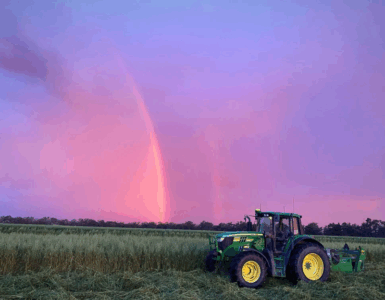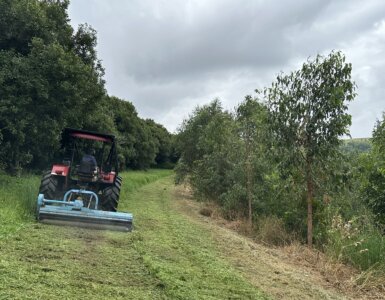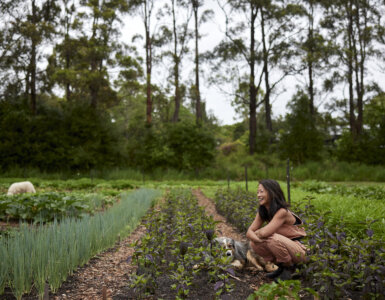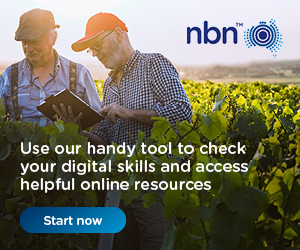Twenty-five years ago, Danielle Statham couldn’t tell you a thing about cotton.
Today, alongside husband David, she stands at the helm of the world’s first carbon positive, sustainable, traceable and most ethical cotton-producing company, aptly-named Good Earth Cotton.
Grown by the couple’s own Sundown Pastoral Company at Keytah in Moree, the cotton is produced by an environmentally-passionate team of farmers using the world’s most advanced and ecologically-innovative production techniques.
The story of sustainable cotton
Their business motto is simple: every fibre tells a story – and Danielle’s on a mission to share that story with the world.
“Sustainable cotton has a valuable place in the market,” Danielle says.
“So we must prove this value proposition to remain relevant alongside other sustainable fibres.
“Cotton has been such a dominant fibre for so many years, and as cotton farmers we’re doers – we get out there and we get it done and we say goodbye at the farm gate.
“But if we want to maintain our value position as an industry, especially now other sustainable fibres have entered the marketplace, we need to prove our worth.”
Danielle knows she can’t just go out there and say that they’re sustainable – that’s why she’s supporting words with data.
“Because the story we tell needs to be truthful, it needs to be meaningful and it needs to allow consumers to make informed purchasing decisions. But not only that, it needs to allow the fashion companies, small and large, to manage their supply chain risks so they too can go out there and tell a positive story about their emissions, their energy consumption and their social compliance,” Danielle says.

Connecting cotton and customers
That’s where FibreTrace comes in – Danielle’s recently-launched, global-reaching, blockchain-based tracking platform that uses patented technology with embedded luminescent pigments so the full supply chain including shoppers can check the origins of a garment, along with the farm’s production methods, at the ‘swipe of a finger’ using in-store Bluetooth scanners or their mobile phone.
In short, this technology connects the physical tracer and the digital platform in one system, making this a very unique transparency solution.
Back at the farm gate, Good Earth Cotton’s high-quality cotton fibres are independently certified as carbon positive, environmentally-sustainable and fully-traceable in real-time throughout the entire fashion chain, through to recycle with a no waste, no finish line.
It’s a ‘seed to shelf’ story that has never before been shared with the world, one that brands, designers and consumers alike are hungry for.
“We’ve always captured good benchmarking data at our own property, Keytah, and we’ve worked hard to follow best practices. But I wanted to know more – I wanted a deeper understanding of our carbon scores and I wanted to find a way for other farmers to easily capture that data too,” Danielle says.
Calling in the carbon experts
So Danielle reached out to Professor Francois Visser at the University of Queensland. Visser had previously worked in the cotton industry and is an expert in carbon science with a PhD on carbon levels in soil, making him well placed to complete a full audit on Keytah.
“I told him I wanted to understand everything that we’re doing,” says Danielle.
“I wanted to know how much carbon we’re emitting from the crops, how much we were creating per bale, right down to per gram of cotton at the spinning mill. I wanted to know exactly what goes into the yarn we create and the t-shirts that use our fabric.
Ultimately I wanted to know if the fibre in a particular garment sequestered carbon, or emitted carbon by using our cotton.”
When the results came in, Danielle was thrilled to discover the research and technology carried out at Keytah over the past decade or so are the result of true regenerative farming.
“We are sequestering carbon. And while we have some native vegetation that contributes to that, our soil sequesters the majority of the carbon emissions. So while native vegetation plays an important role, we need to be sequestering the carbon in the soil where we are growing our fibre.”
“It’s a move that’s crucial for smaller farming plots in certain areas of Australia that simply don’t have native vegetation – I believe that’s where we need to go as an industry.”

Technology to improve emissions, water consumption or energy use
Danielle’s next farming innovation – the Fibre Impact Module – has been designed to lead the industry in that very direction. She describes the integrated benchmarking platform as “an app of Professor Visser’s brain to help farmers capture their primary farm data and load it onto the platform for further tracking and analysis”.
The process shouldn’t take longer than 10 minutes and will flag any results requiring attention with the farmer so they can improve their farm emissions, water consumption or energy consumption, whatever the case may be.
“We’ve essentially created a tool which allows the collection of farming data with third party verification of these results.
What we would like to see is continuous improvement in carbon sequestration, maintaining yield and water efficiencies – while lowering your footprint is the aim,” Danielle explains.
“Not only is it a win for the brands, the consumers and the environment, but it’s a win for the farmer because it proves their worth, it proves the value of true sustainable cotton fibres and farmers should be rewarded for the technology implemented and the care they have taken to produce that crop in an ethical and sustainable manner. But we must have data to demonstrate and support our story with numbers and science.
“When we do that we improve our chances of positioning ourselves within the sustainable fibre market and farmers being paid accordingly for their extra efforts.
For too long the farmer has been at the mercy of institutions outside of their control.
“But we’re changing the narrative and we’re going to create this with the addition of scientific data and third party verified methodologies that are physically traced in real time. After all, every fibre has a story, and it’s time the world listened to what cotton has to say.”
To find out more, visit Good Earth Cotton.







































Add comment